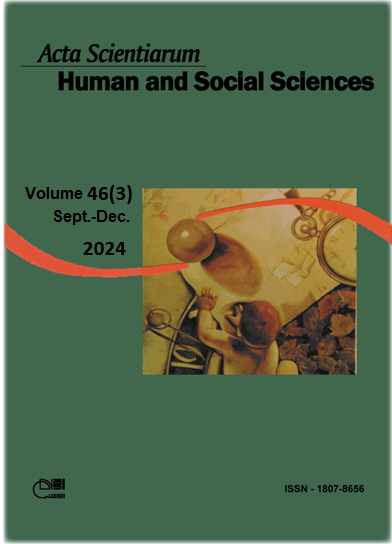The schillerianism of Dmitri Karamazov: the problem of aesthetic education in The Brothers Karamazov
Abstract
This article proposes a comparative analysis between The Brothers Karamazov and Schiller's philosophical work, focusing on the character Dmitri Karamazov. The introduction highlights how Dostoevsky appropriates Schiller through a Christianized and Russified interpretation of his philosophy, explaining the affinities and similarities between the two authors. The first section investigates how Dmitri embodies the immature aesthetic type, already theorized by Schiller. The second section, divided into two subsections, explores Dmitri's aesthetic and moral formation in light of Schiller's categories of love and the sublime. The study culminates in the interpretation of Dmitri as a tragic hero, according to the aesthetic categorization proposed by Schiller.
Downloads
References
Referências
Achlei, R. C. C. (2022). Belo ou sublime? Artefilosofia, 17(31), 174-201.
Beiser, F. C. (2005). Schiller as philosopher: a re-examination. Oxford, UK: University Press.
Bíblia. (2017). Novo testamento-Os quatro evangelhos (Volume I:, F. Lourenço Trad., notas e comentários, [ebook]). São Paulo, SP: Editora Companhia das Letras.
Brown, R. E. (1966). The Gospel According to John, I-XII.Rio de Janeiro, RJ: Anchor Bible.
Cecchinato, G. (2015). O impulso lúdico e o espaço político em F. Schiller. Ipseitas, 159-165.
Čyževśkyj, D. (1929). Schiller und die Brüder Karamazov. Zeitschrift für slavische Philologie, 6(1/2), 1-42.
Dostoiévski, F. (2016). Diário de um Escritor (ebook). São Paulo, SP: Hedra.
Dostoiévski, F. (2009). Memórias do subsolo (ebook). São Paulo, SP: Editora 34.
Dostoievski, F. M. (2011). O crocodilo: e notas de inverno sobre impressões de verão (ebook). São Paulo, SP: Editora 34.
Dostoiévski, F. (2023). Os irmãos Karamázov (ebook). São Paulo, SP: Editora 34.
Dostoiévski, F. (1987). Selected Letters (J. Frank, & D. I. Goldstein, Eds.). New Brunswick, NJ: Rutgers University Press.
Dostoiévski, F. (1919). The Diary of a Writter. New York, NY: George Braziller.
Frank, J. (2007). Dostoiévski: o manto do profeta (1871-1881). São Paulo, SP: Edusp.
Frank, J. (1986). Dostoevsky: the stir of liberation (1860-1865). Princeton, NJ: Princeton University Press.
Jackson, R. L. (1965). Dmitrij Karamazov and the “Legend”. The Slavic and east European Journal, 9(3), 257-267.
Jones, M. V. (1974). Dostoyevsky and an Aspect of Schiller's Psychology. The Slavonic and East European Review, 52(128), 337-354.
Kirillova, I. (2001). Dostoevsky’s marking in the Gospel according to St John. In J. Sutton (Org.), Dostoevsky and the Christian Tradition (p. 41-51). Cambridge, ENG: Cambridge University Press.
Kostka, E. K. (1965). Schiller in Russian literature. Philadelphia, PA: University of Pennsylvania Press.
Robinson, J. A. (1960). The destination and purpose of St John's gospel. New Testament Studies, 6(2), 117-131.
Schiller, F. (1996). A educação estética do homem. São Paulo, SP: Editora Iluminuras Ltda.
Schiller, F., & Von Goethe, J. W. (1845). Correspondence Between Schiller and Goethe, from 1794 to 1805 (1794-1797). New York, NY and London, UK: Wiley and Putnam.
Schiller, F. (2016). Do sublime ao trágico. Belo Horizonte, MG: Autêntica.
Schiller, F. (2018). Objetos trágicos, objetos estéticos. Belo Horizonte, MG: Autêntica.
Schiller, F. (2008). Sobre graça e dignidade. Porto Alegre, RS: Movimento.
Terras, V. (1981). A Karamazov companion: commentary on the genesis, language, and style of Dostoevsky's novel. Madison, WI: Univ of Wisconsin Press.
Van Kooten, G. (2018). Bildung, religion, and politics in the gospel of john: the erastic, philhellenic, anti-maccabean, and anti-roman tendencies of the gospel of ‘the Beloved Pupil’. In F. Wilk (Ed.), Scriptural interpretation at the interface between education and religion: In memory of Hans Conzelmann (p. 123-177). Boston: Brill.
DECLARATION OF ORIGINALITY AND COPYRIGHTS
I Declare that current article is original and has not been submitted for publication, in part or in whole, to any other national or international journal.
The copyrights belong exclusively to the authors. Published content is licensed under Creative Commons Attribution 4.0 (CC BY 4.0) guidelines, which allows sharing (copy and distribution of the material in any medium or format) and adaptation (remix, transform, and build upon the material) for any purpose, even commercially, under the terms of attribution.
Read this link for further information on how to use CC BY 4.0 properly.























